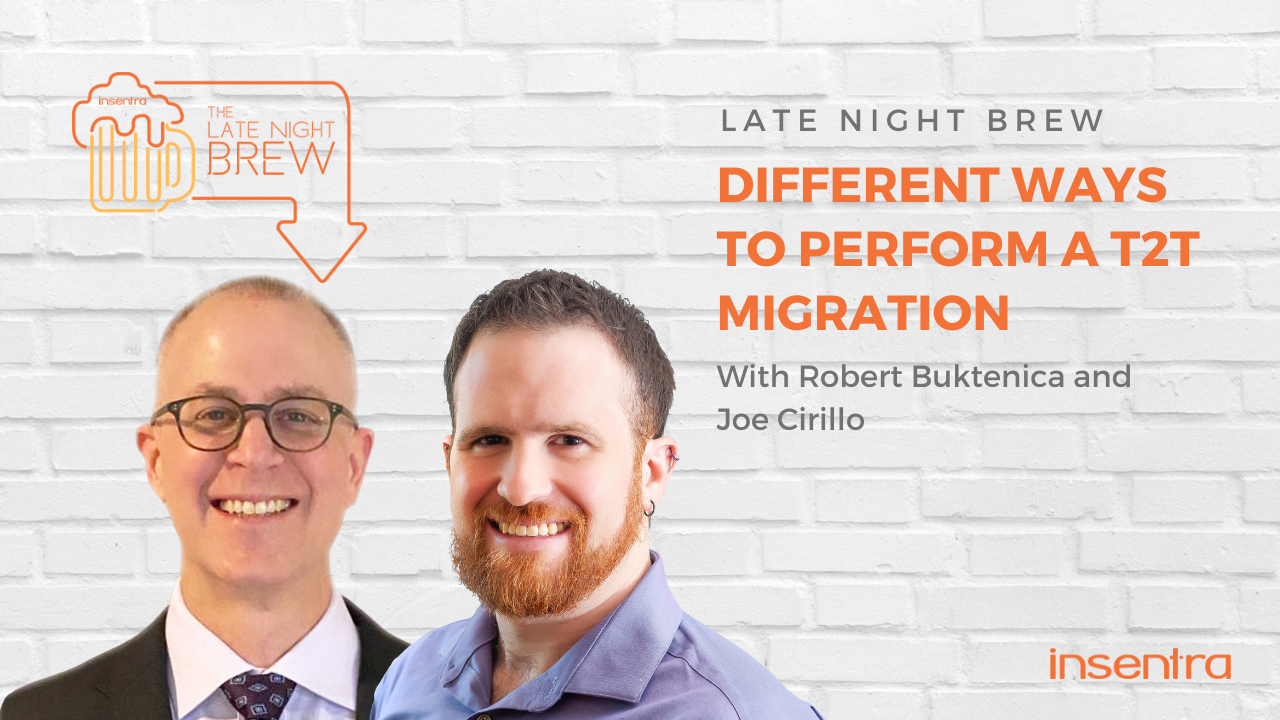We’re on to the sixth episode of Late Night Brew: Tenant-to-Tenant Migration! Now that we’ve covered everything about planning, it’s time for the main event: the execution.
So, how exactly do you perform a tenant migration? What are the different ways to do so and who should be involved in the discussion?
These are the questions Robert Buktenica and Joe Cirillo are answering in today’s episode. So, grab a brew, sit back, and tune in to this discussion now!
TIMESTAMP
00:07 – Introduction
00:42 – The Brew
01:55 – What are the different ways to perform a migration?
05:30 – Who should be part of the migration discussion?
Introduction
Robert Buktenica: Hello, everyone, and welcome to another episode of the Late Night Brew, where we talk the brews first, then we get around to it. I am your host, Robert Buktenica or Buck, and joining with me for the next episode of the Tenant-to-Tenant Migration series is Joe.
Welcome back, once again.
Joe Cirillo: Yeah, welcome to be here. Thank you.
The Brew
Robert: Before we dive into the migration approach, planning, all of that in-depth preparatory stuff for getting the big move going, we know, of course, the drill. What brew do you have with me today?
Joe: Well, actually, I’m stepping out today. I’m actually having—I’m not usually a big seltzer fan, but I don’t know if you can see. It’s a Truly, it’s the strawberry lemonade. I’m a big lemonade fan, and I’m a flavored lemonade fan, so I thought I’d try it. It’s not too bad. I’m not usually a big carbonated guy, but it works.
Robert: Really fair. I was going to say the last one, you were having pop, and now you’re having a seltzer. What’s going on, Joe?
Joe: I know. Crazy. It’s getting wild.
Robert: I was going to say “Twice now, my goodness.” It’s from the keg, but it is citrus season and so I have lots of fresh orange juice, so I’m doing my shandy of 50-50 orange juice and half beer, so I don’t have a fun label to show or anything but I am very much enjoying the fruits of my labor.
Joe: Yeah, I love orange juice, and I’m sure it’s delicious.
Robert: Yeah, when it’s fresh squeezed, it’s really good. I will be very sad when the season ends and I will finally run out.
What are the different ways to perform a migration?
Robert: On that, what are the different ways to perform a migration?
Joe: Yeah, that’s a very nebulous question, of course.
Robert: Got to keep you on your toes.
Joe: Yeah, there’s a lot of ways to carve out a tenant migration. Of course, the first and most critical component of planning any migration is to come up with a migration plan. That’s really going to be your roadmap to how to execute the actual migration.
It’s important to actually put it on paper, plan it all out, get sign-off from everybody so that should you have to make an adjustment, at least you have a documented record of decisions on how we were going to proceed and the reasons why we were going with that approach, so that if you have to shift, you can make the adjustments accordingly.
That’s a big part of it, and then, of course, testing, testing, testing. It’s always good to have a test plan as well. You don’t just want to dive and start migrating production users, so having a valid test plan with test cases that, again, align to your business requirements and your business processes.
It’s easy. From a test case perspective, you can think of a very simple test case of, has all the data migrated from one mailbox to another? What if you have a unique use case where you maybe have an application that’s sending to that mailbox? You want to make sure that you include those types of test cases as well to make sure that, yep, mail is still flowing even after we do the migration.
So those are a couple of different critical components, but when you actually get into the execution of the migration, or I should say, identify strategies for the migration, there are some definite strategies in conducting a tenant migration.
The first being, Microsoft heavily throttles on the SharePoint side, especially during the week. And when you think about all of the different workloads that you might be migrating as part of, quote, unquote, SharePoint, so SharePoint, Teams, OneDrive groups, right? Yeah, the backend for all of those is SharePoint.
So, it’s not like within the migration tool, you can just kick off all of those workloads all at once. So you really have to think about what’s the priority. And usually it’s the user data, even from a mailbox perspective.
You want to make sure that from a mailbox perspective, the user has the most current email, the most current calendar information. And then you can trail things like the dumpster, you know, or an archive mailbox, right, that aren’t as critical that they don’t need day one. So, you can trickle those in after the cut-over.
Same thing with SharePoint, OneDrive, Teams groups, right? It’s usually OneDrive is the primary workload to get over so that the user can immediately start working with their most current data. And then you have to come up with, again, a strategy for the other workloads, right. Other some critical—what are the top five, 10, 15, 20 critical SharePoint sites, Teams, you know, and so forth, that you might have to do those migrations first and then trickle in, you know, all the other remaining sites. So if you get stack rank and so forth.
Who should be part of the migration discussion?
Robert: So with all of these, you know—and I know we’re just scratching the surface of the reality of it—with mapping all of this out and understanding, you know, the layers and the when and what, really, who all should be part of these discussions? I mean, beyond just IT, right, the techs who are actually going to be helping out and supporting. But you know, who else needs to be involved in conversations to understand and craft all of this?
Joe: Yeah, well, the data owners for sure. So again, when you think SharePoint, right, you have data owners, most likely site owners, and so forth, that they have to be a part of that, because only they can know what’s critical and what’s not.
So, you have to get them involved so you can determine again what goes first, what goes last, you know, that type of thing. So that’s very important.
And then I know we talked a lot about the communications planning as well. So getting the end users involved, and just making sure they’re fully aware of what’s coming as well, because they might have some concerns, or know of specific use cases that have to be addressed as part of this as well.
Robert: Awesome. Well, lots and lots there. And I’m sure we can spend lots of more time. We do have a few more episodes to film. So there will be. Please, if you have any more questions or want to know more, reach out.
We are here to help. And so… take care. Have a great rest of your day, Sir.
Joe: Yeah, you too, Sir. Take care.
Planning, testing and communication are the keys to a successful migration. These three will help you make sure that you’ve migrated all the critical components and workloads with minimal disruption to daily operations.
If you’d like to learn more about tenant migrations, feel free to check out our full series on Late Night Brew or download our A Comprehensive Guide to Microsoft 365 Tenant Migrations eBook.
Reach out to us or explore our MapTo advisory services for expert assistance in your tenant migration projects.











